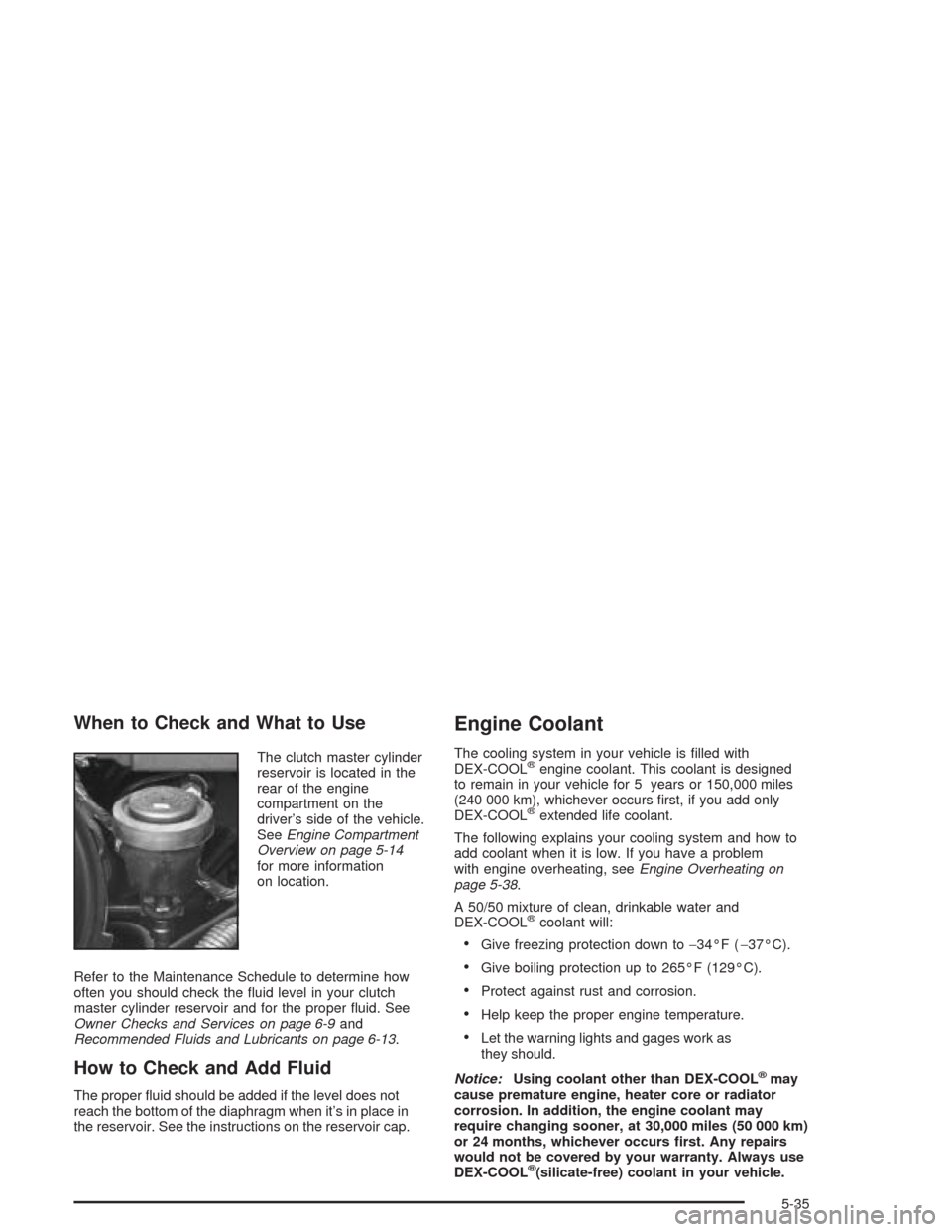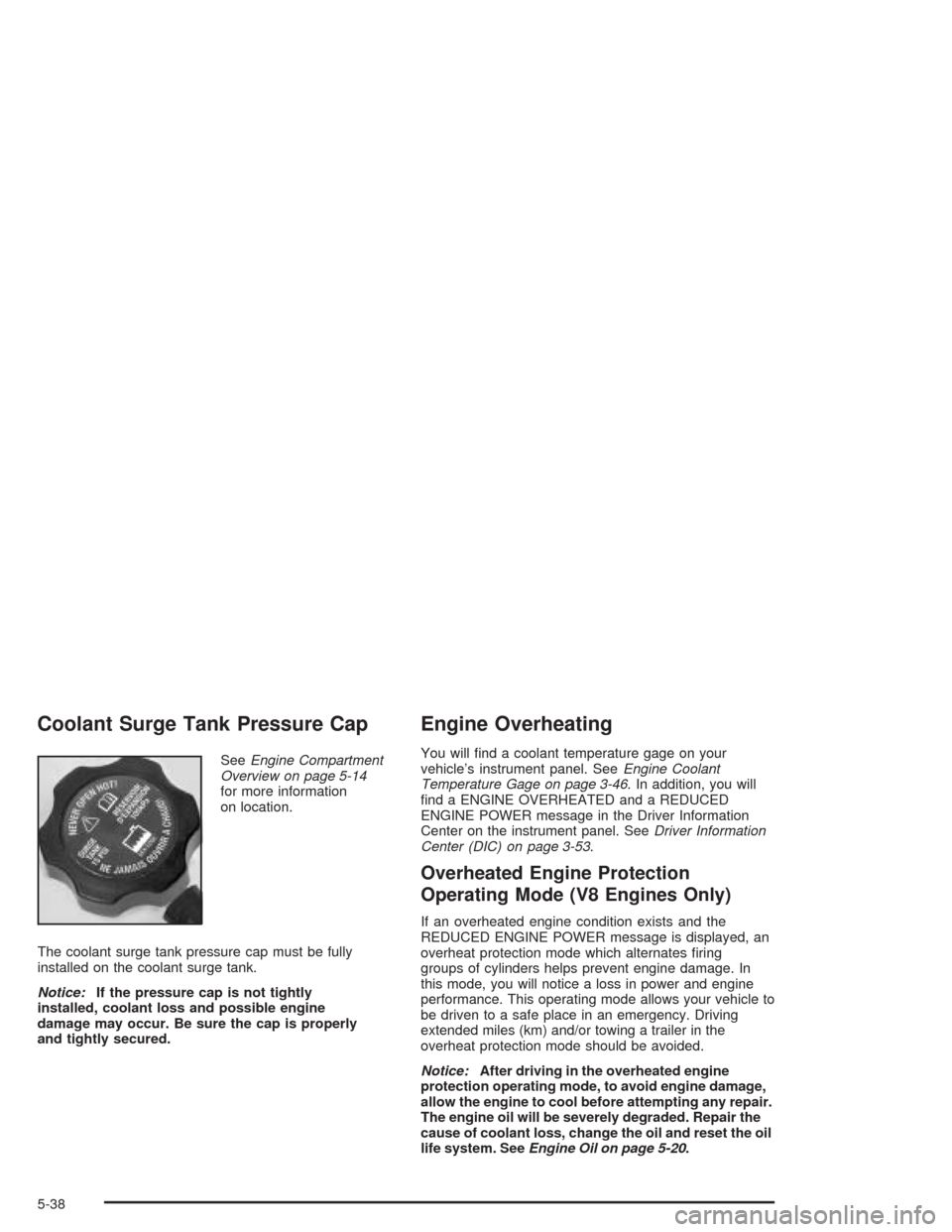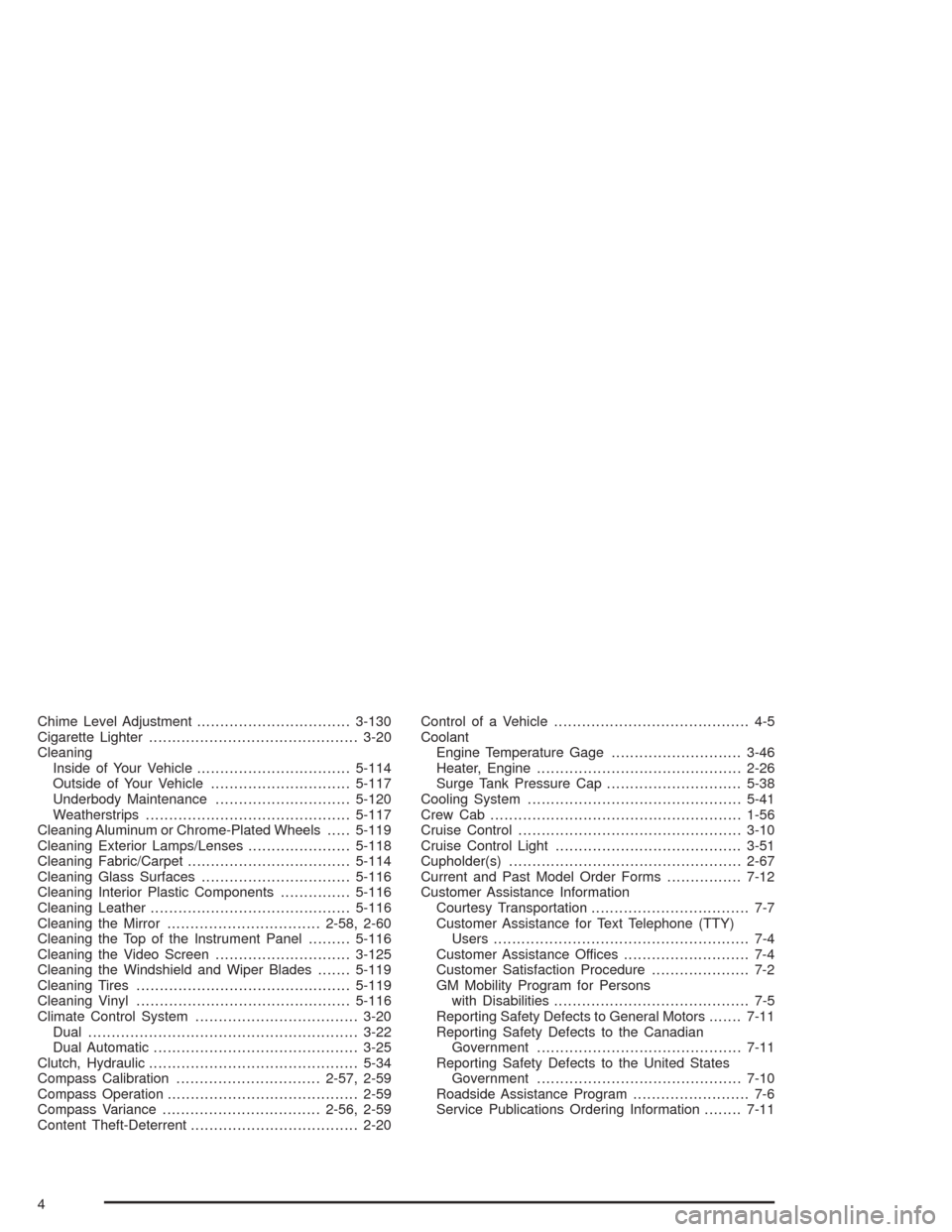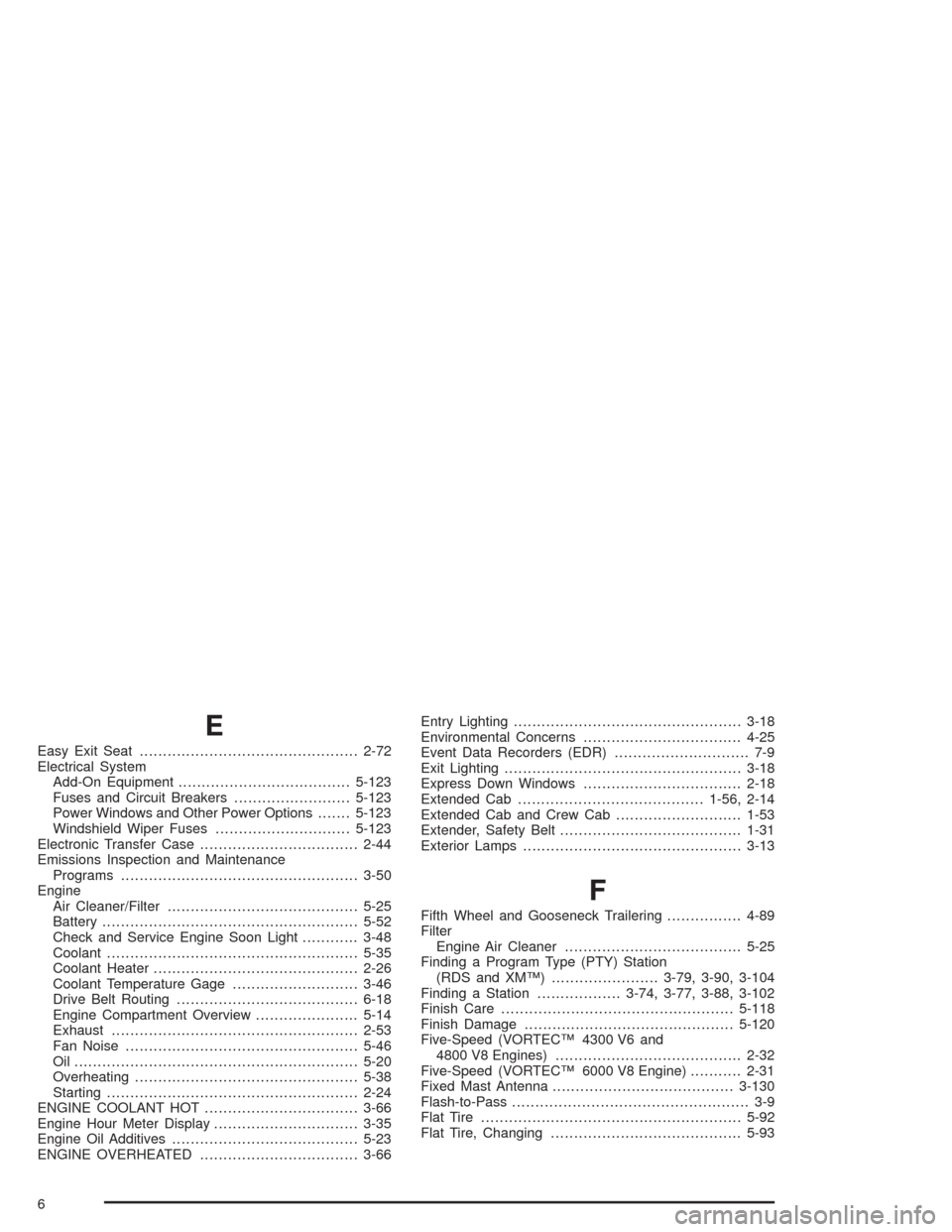2004 CHEVROLET SILVERADO coolant temperature
[x] Cancel search: coolant temperaturePage 387 of 584

If you have a 5-speed manual transmission and you are
towing a trailer, it’s better not to use FIFTH (5) gear.
Just drive in FOURTH (4) gear (or, as you need
to, a lower gear).
If you have a 6-speed manual transmission and you
are towing a trailer, it’s better not to use SIXTH (6)
gear. Drive in FIFTH (5) gear (or, as you need to, a
lower gear).
When towing at high altitude on steep uphill grades,
consider the following: Engine coolant will boil at a lower
temperature than at normal altitudes. If you turn your
engine off immediately after towing at high altitude
on steep uphill grades, your vehicle may show signs
similar to engine overheating. To avoid this, let the
engine run while parked, preferably on level ground, with
the automatic transmission in PARK (P) for a few
minutes before turning the engine off. For manual
transmissions, let the engine run while parked,
preferably on level ground, with the transmission out of
gear and the parking brake applied, for a few minutes
before turning the engine off. If you do get the overheat
warning, seeEngine Overheating on page 5-38.Parking on Hills
{CAUTION:
You really should not park your vehicle, with a
trailer attached, on a hill. If something goes
wrong, your rig could start to move. People
can be injured, and both your vehicle and the
trailer can be damaged.
But if you ever have to park your rig on a hill, here’s
how to do it:
1. Apply your regular brakes, but don’t shift into
PARK (P) yet for an automatic transmission,
or into gear for a manual transmission.
2. Have someone place chocks under the
trailer wheels.
3. When the wheel chocks are in place, release the
regular brakes until the chocks absorb the load.
4. Reapply the regular brakes. Then apply your
parking brake and shift into PARK (P) for an
automatic transmission, or REVERSE (R) for a
manual transmission.
4-93
Page 431 of 584

When to Check and What to Use
The clutch master cylinder
reservoir is located in the
rear of the engine
compartment on the
driver’s side of the vehicle.
SeeEngine Compartment
Overview on page 5-14
for more information
on location.
Refer to the Maintenance Schedule to determine how
often you should check the �uid level in your clutch
master cylinder reservoir and for the proper �uid. See
Owner Checks and Services on page 6-9and
Recommended Fluids and Lubricants on page 6-13.
How to Check and Add Fluid
The proper �uid should be added if the level does not
reach the bottom of the diaphragm when it’s in place in
the reservoir. See the instructions on the reservoir cap.
Engine Coolant
The cooling system in your vehicle is �lled with
DEX-COOL®engine coolant. This coolant is designed
to remain in your vehicle for 5 years or 150,000 miles
(240 000 km), whichever occurs �rst, if you add only
DEX-COOL
®extended life coolant.
The following explains your cooling system and how to
add coolant when it is low. If you have a problem
with engine overheating, seeEngine Overheating on
page 5-38.
A 50/50 mixture of clean, drinkable water and
DEX-COOL
®coolant will:
Give freezing protection down to−34°F (−37°C).
Give boiling protection up to 265°F (129°C).
Protect against rust and corrosion.
Help keep the proper engine temperature.
Let the warning lights and gages work as
they should.
Notice:Using coolant other than DEX-COOL
®may
cause premature engine, heater core or radiator
corrosion. In addition, the engine coolant may
require changing sooner, at 30,000 miles (50 000 km)
or 24 months, whichever occurs �rst. Any repairs
would not be covered by your warranty. Always use
DEX-COOL
®(silicate-free) coolant in your vehicle.
5-35
Page 434 of 584

Coolant Surge Tank Pressure Cap
SeeEngine Compartment
Overview on page 5-14
for more information
on location.
The coolant surge tank pressure cap must be fully
installed on the coolant surge tank.
Notice:If the pressure cap is not tightly
installed, coolant loss and possible engine
damage may occur. Be sure the cap is properly
and tightly secured.
Engine Overheating
You will �nd a coolant temperature gage on your
vehicle’s instrument panel. SeeEngine Coolant
Temperature Gage on page 3-46. In addition, you will
�nd a ENGINE OVERHEATED and a REDUCED
ENGINE POWER message in the Driver Information
Center on the instrument panel. SeeDriver Information
Center (DIC) on page 3-53.
Overheated Engine Protection
Operating Mode (V8 Engines Only)
If an overheated engine condition exists and the
REDUCED ENGINE POWER message is displayed, an
overheat protection mode which alternates �ring
groups of cylinders helps prevent engine damage. In
this mode, you will notice a loss in power and engine
performance. This operating mode allows your vehicle to
be driven to a safe place in an emergency. Driving
extended miles (km) and/or towing a trailer in the
overheat protection mode should be avoided.
Notice:After driving in the overheated engine
protection operating mode, to avoid engine damage,
allow the engine to cool before attempting any repair.
The engine oil will be severely degraded. Repair the
cause of coolant loss, change the oil and reset the oil
life system. SeeEngine Oil on page 5-20.
5-38
Page 541 of 584

(g)Add �uid as needed. A �uid loss could indicate a
problem; repair as needed. Check vent hose at transfer
case for kinks and proper installation.
(h)Change automatic transmission �uid and �lter if the
vehicle GVWR is over 8600 lbs. or if the vehicle is
mainly driven under one or more of these conditions:
�In heavy city traffic where the outside temperature
regularly reaches 90°F (32°C) or higher.
�In hilly or mountainous terrain.
�When doing frequent trailer towing.
�Uses such as found in taxi, police or
delivery service.
(i)Drain, �ush and re�ll cooling system. See Engine
Coolant on page 5-35for what to use. Inspect hoses.
Clean radiator, condenser, pressure cap and �ller neck.
Pressure test the cooling system and pressure cap.
(j)A �uid loss in any vehicle system could indicate a
problem. Have the system inspected and repaired and
the �uid level checked. Add �uid if needed.
(k)Inspect system. Check all fuel and vapor lines and
hoses for proper hook-up, routing and condition.
Check that the purge valve works properly (if equipped).
Replace as needed.(l)Change clutch �uid (or every 24 months, whichever
occurs �rst).
(m)Change automatic transmission �uid and �lter if
the vehicle is mainly driven under one or more of
these conditions:
�In heavy city traffic where the outside temperature
regularly reaches 90°F (32°C) or higher.
�In hilly or mountainous terrain.
�When doing frequent trailer towing.
�Uses such as found in taxi, police or
delivery service.
Owner Checks and Services
These owner checks and services should be performed
at the intervals speci�ed to help ensure the safety,
dependability and emission control performance of your
vehicle. Your GM Goodwrench dealer can assist you
with these checks and services.
Be sure any necessary repairs are completed at once.
Whenever any �uids or lubricants are added to your
vehicle, make sure they are the proper ones, as shown
inRecommended Fluids and Lubricants on page 6-13.
6-9
Page 570 of 584

Chime Level Adjustment.................................3-130
Cigarette Lighter.............................................3-20
Cleaning
Inside of Your Vehicle.................................5-114
Outside of Your Vehicle..............................5-117
Underbody Maintenance.............................5-120
Weatherstrips............................................5-117
Cleaning Aluminum or Chrome-Plated Wheels.....5-119
Cleaning Exterior Lamps/Lenses......................5-118
Cleaning Fabric/Carpet...................................5-114
Cleaning Glass Surfaces................................5-116
Cleaning Interior Plastic Components...............5-116
Cleaning Leather...........................................5-116
Cleaning the Mirror.................................2-58, 2-60
Cleaning the Top of the Instrument Panel.........5-116
Cleaning the Video Screen.............................3-125
Cleaning the Windshield and Wiper Blades.......5-119
Cleaning Tires..............................................5-119
Cleaning Vinyl..............................................5-116
Climate Control System...................................3-20
Dual..........................................................3-22
Dual Automatic............................................3-25
Clutch, Hydraulic.............................................5-34
Compass Calibration...............................2-57, 2-59
Compass Operation.........................................2-59
Compass Variance..................................2-56, 2-59
Content Theft-Deterrent....................................2-20Control of a Vehicle.......................................... 4-5
Coolant
Engine Temperature Gage............................3-46
Heater, Engine............................................2-26
Surge Tank Pressure Cap.............................5-38
Cooling System..............................................5-41
Crew Cab......................................................1-56
Cruise Control................................................3-10
Cruise Control Light........................................3-51
Cupholder(s)..................................................2-67
Current and Past Model Order Forms................7-12
Customer Assistance Information
Courtesy Transportation.................................. 7-7
Customer Assistance for Text Telephone (TTY)
Users....................................................... 7-4
Customer Assistance Offices........................... 7-4
Customer Satisfaction Procedure..................... 7-2
GM Mobility Program for Persons
with Disabilities.......................................... 7-5
Reporting Safety Defects to General Motors.......7-11
Reporting Safety Defects to the Canadian
Government............................................7-11
Reporting Safety Defects to the United States
Government............................................7-10
Roadside Assistance Program......................... 7-6
Service Publications Ordering Information........7-11
4
Page 572 of 584

E
Easy Exit Seat...............................................2-72
Electrical System
Add-On Equipment.....................................5-123
Fuses and Circuit Breakers.........................5-123
Power Windows and Other Power Options.......5-123
Windshield Wiper Fuses.............................5-123
Electronic Transfer Case..................................2-44
Emissions Inspection and Maintenance
Programs...................................................3-50
Engine
Air Cleaner/Filter.........................................5-25
Battery.......................................................5-52
Check and Service Engine Soon Light............3-48
Coolant......................................................5-35
Coolant Heater............................................2-26
Coolant Temperature Gage...........................3-46
Drive Belt Routing.......................................6-18
Engine Compartment Overview......................5-14
Exhaust.....................................................2-53
Fan Noise..................................................5-46
Oil .............................................................5-20
Overheating................................................5-38
Starting......................................................2-24
ENGINE COOLANT HOT.................................3-66
Engine Hour Meter Display...............................3-35
Engine Oil Additives........................................5-23
ENGINE OVERHEATED..................................3-66Entry Lighting.................................................3-18
Environmental Concerns..................................4-25
Event Data Recorders (EDR)............................. 7-9
Exit Lighting...................................................3-18
Express Down Windows..................................2-18
Extended Cab........................................1-56, 2-14
Extended Cab and Crew Cab...........................1-53
Extender, Safety Belt.......................................1-31
Exterior Lamps...............................................3-13
F
Fifth Wheel and Gooseneck Trailering................4-89
Filter
Engine Air Cleaner......................................5-25
Finding a Program Type (PTY) Station
(RDS and XM™).......................3-79, 3-90, 3-104
Finding a Station..................3-74, 3-77, 3-88, 3-102
Finish Care..................................................5-118
Finish Damage.............................................5-120
Five-Speed (VORTEC™ 4300 V6 and
4800 V8 Engines)........................................2-32
Five-Speed (VORTEC™ 6000 V8 Engine)...........2-31
Fixed Mast Antenna.......................................3-130
Flash-to-Pass................................................... 3-9
Flat Tire........................................................5-92
Flat Tire, Changing.........................................5-93
6
Page 573 of 584

Fluid
Automatic Transmission........................5-27, 5-30
Manual Transmission....................................5-33
Power Steering...........................................5-46
Windshield Washer......................................5-47
FM Stereo....................................................3-128
Fog Lamps....................................................3-16
Folding the Rear Seat....................................... 1-9
Following Distance..........................................4-91
Four-Wheel Drive....................................2-36, 5-60
Four-Wheel-Drive Light....................................3-51
Front Axle Locking Feature...............................2-36
Front Reading Lamps......................................3-18
Front Storage Area.........................................2-68
Fuel............................................................... 5-5
Additives...................................................... 5-7
California Fuel.............................................. 5-6
E-85 (85% Ethanol)....................................... 5-8
Filling a Portable Fuel Container....................5-11
Filling Your Tank........................................... 5-9
Fuels in Foreign Countries.............................. 5-9
Gage.........................................................3-52
Gasoline Octane........................................... 5-5
Gasoline Speci�cations.................................. 5-6
Low Warning Light.......................................3-53Fuel Information Button....................................3-56
FUEL LEVEL LOW.........................................3-66
Fuses
Fuses and Circuit Breakers.........................5-123
Windshield Wiper.......................................5-123
G
Gage
Engine Coolant Temperature.........................3-46
Fuel..........................................................3-52
Oil Pressure...............................................3-50
Speedometer..............................................3-35
Tachometer.................................................3-35
Transmission Temperature.............................3-46
Voltmeter Gage...........................................3-42
Gasoline
Octane........................................................ 5-5
Speci�cations............................................... 5-6
Getting Familiar with Off-Road Driving................4-25
Glove Box.....................................................2-67
GM Mobility Program for Persons with
Disabilities.................................................... 7-5
7
Page 576 of 584

Loss of Control...............................................4-20
LOW COOLANT LEVEL..................................3-67
Low Fuel Warning Light...................................3-53
Lumbar
Power Controls............................................. 1-5
M
Maintenance Schedule
Additional Required Services........................... 6-6
At Each Fuel Fill.........................................6-10
At Least Once a Month................................6-10
At Least Once a Year..................................6-11
At the First 100, 1,000 and 6,000 Miles
(160, 1 600 and 10 000km).......................6-10
Introduction.................................................. 6-2
Maintenance Footnotes.................................. 6-8
Maintenance Record....................................6-19
Maintenance Requirements............................. 6-2
Normal Maintenance Replacement Parts.........6-16
Owner Checks and Services........................... 6-9
Recommended Fluids and Lubricants.............6-13
Scheduled Maintenance................................. 6-4
Using Your................................................... 6-3
Your Vehicle and the Environment................... 6-2
Maintenance When Trailer Towing.....................4-94
Making Turns.................................................4-92
Malfunction Indicator Light................................3-48Manual Seats................................................... 1-3
Manual Selectable Ride...................................4-11
Manual Transfer Case.....................................2-37
Manual Transmission...............................2-25, 2-52
Fluid..........................................................5-33
Operation...................................................2-31
Manual Windows............................................2-17
Matching Transmitter(s) to Your Vehicle............... 2-6
Memory Seat.................................................2-70
Message
DIC Warnings and Messages........................3-64
Mexico, Central America and Caribbean
Islands/Countries (Except Puerto Rico and
U.S. Virgin Islands) – Customer Assistance....... 7-5
Mirrors
Automatic Dimming Rearview with Compass
and Temperature Display...........................2-58
Automatic Dimming Rearview with OnStar
®,
Compass and Temperature Display.............2-55
Manual Rearview Mirror................................2-55
Outside Automatic Dimming Mirror.................2-64
Outside Camper-Type Mirrors........................2-61
Outside Convex Mirror.................................2-65
Outside Curb View Assist Mirrors...................2-64
Outside Heated Mirrors................................2-65
Outside Manual Mirrors................................2-60
Outside Power Camper-Type.........................2-62
Outside Power Foldaway Mirrors....................2-63
10